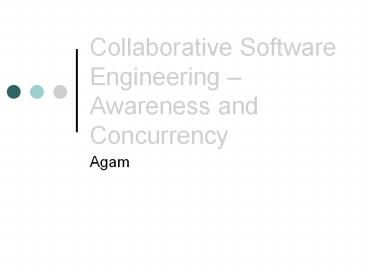Collaborative Software Engineering Awareness and Concurrency - PowerPoint PPT Presentation
Title:
Collaborative Software Engineering Awareness and Concurrency
Description:
Visualization of CVS a good idea. tickertape' mechanism used to broadcast recent CVS activity to team ' ... Private (traditional) mode similar to cvs ... – PowerPoint PPT presentation
Number of Views:75
Avg rating:3.0/5.0
Title: Collaborative Software Engineering Awareness and Concurrency
1
Collaborative Software Engineering Awareness
and Concurrency
- Agam
2
Outline
- Introduction to CSE
- Brief overview of five recent papers
- Synthesis with in-class discussion
3
Introduction to CSE
- Seamless, fine-grained, real-time collaboration
between geographically distributed software
engineers - Example
- Pair programming
- Refactoring
- Working on any part of the software
design/analysis process as a distributed team
4
Introduction to CSE (contd.)
- Research Areas in CSE
5
Introduction to CSE (contd.)
- Design space of CSE tools lies between two
extremes (optimistic, pessimistic)
6
Brief overview of papers
- Interruptions on Software Teams A Comparison of
Paired and Solo Programmers - J. Chong, R. Siino
- CSCW 2006
- CVS Integration with Notification and Chat
Lightweight Software Team Collaboration - G. Fitzpatrick, P. Marshall, A. Phillips
- CSCW 2006
7
Brief overview of papers (contd.)
- A User Evaluation of Synchronous Collaborative
Software Engineering Tools - C. Cook, W. Irvin, N. Churcher
- APSEC 2005
- Towards Synchronous Collaborative Software
Engineering - C. Cook, N. Churcher, W. Irvin
- APSEC 2004
- Modelling and Measuring Collaborative Software
Engineering - C. Cook, N. Churcher
- ACSC 2005
8
Lightweight Software Team collaboration
- Communication
- Mediated
- Informal
- Idea public awareness of CVS contents as a means
of communication - Currently being performed (in a weak sense) by
mailing lists
9
Lightweight Software Team collaboration
(contd.)
- Most prevalent form of CSE version control !!
- Idea combine this with informal communication
- Result mediated communication
10
Lightweight Software Team collaboration
(contd.)
- Visualization of CVS a good idea
- tickertape mechanism used to broadcast recent
CVS activity to team - publish/subscrive system displays entry/group/developer
- Made users aware of manipulation of project
artifacts - Studied interaction/discussion arising from
11
Lightweight Software Team collaboration
(contd.)
- Results of study
- Stimulated developer discussion
- Promoted awareness
- CVS log had better context, more info
- Helps document flow (commentary !)
12
Lightweight Software Team collaboration
(contd.)
- Results of study (contd.)
- commit operation public act (as it should be,
marking transition of code from private workspace
to public workspace) Awareness ! - Knowing that other developers are tracking
makes a difference interruptibility management
!
13
Modelling and Measuring CSE
- CSE demands a little more than typical CSCW (E.g.
shared whiteboards) - Longer lifetimes
- Higher conflict resolution cost
- More complexity
- Currently rely on social protocols
14
Modelling and Measuring CSE (contd.)
- CAISE architecture
- Server based
- Semantic model maintained
- Requires parsers/analysers
- Events input/change/feedback
- Supports visualization
15
Modelling and Measuring CSE (contd.)
- Editor Panel
- User Tree
- Client Panel
16
Modelling and Measuring CSE (contd.)
17
Modelling and Measuring CSE (contd.)
- Objectives
- Builds at different temporal granularities
- Fine-grained integrity
- Semantic-based awareness and feedback
- Private work and re-integration
18
Modelling and Measuring CSE (contd.)
- CAISE and CSE
- Provides Taskwork-oriented features (as do
traditional systems) - But also -- Teamwork-oriented features
- Different modes reflecting different approaches
to conflict resolution
19
Modelling and Measuring CSE (contd.)
- Private (traditional) mode similar to cvs
- Independent simultaneos work (CAISE monitors
semantic relationship) - Melee active conflict resolution by developers
(communicate using out-of-band channel) - WYSIWIS tour of the code
20
Modelling and Measuring CSE (contd.)
- Server allows awareness of
- Code dependencies
- Developer relationships
- Visualization see changes to code base over time
21
User evaluation of synchronous CSE (contd.)
- User Study
- Two modes
- Conventional
- Collaborative
- Two types of tasks
- Inter-file
- Intra-file
- Measured task-completion times
22
User evaluation of synchronous CSE (contd.)
- Results
- Collaborative mode twice as fast
- Subjective survey results approved (tools rated
14-15 on a scale of 1-20)
23
Interruptions on Software Teams
- Studied interaction in the workplace, more
specifically knowledge-intensive work - Developers take breaks from work
- Social nature
- Functional nature
- Frequently interrupt each other
24
Interruptions on Software Teams (contd.)
- User study of two situations
- Programmers working as a pair (co-located)
- Programmers working solo (remotely)
25
Interruptions on Software Teams (contd.)
- Observations
- Interruptions both functional social for
solo, largely functional for pair - Pair was harder to interrupt
- interruptibility for pair easier to assess
- Resumption of task/switching tasks faster for pair
26
Interruptions on Software Teams (contd.)
- Observations
- Awareness of interruptiblity Can handle
interruptions better ! - Team pair partner helps maintains state
27
Interruptions on Software Teams (contd.)
- Conclusions
- Design Implication make programmers aware of
multiple tasks to get same benefit for remote
collaboration - Actively maintain context
28
Awareness and Concurrency
- Awareness
- Know what other users are doing
- Helps avoid major conflicts
- Awareness of interruptibility
- Similar to mailing lists
- Conflict Resolution
- Concurrency Control
- Helps avoid developers making conflicting changes
29
Awareness and Concurrency (contd.)
- Conclusion
- Explored three different areas
- Issue of collaboration in software engineering
- Augmenting CVS with simple tool trasforms
developer relationships - CAISE awareness of relationships - conflict
resolution - Awareness related to interruptibility
30
Thank you !
- (Questions ?)































